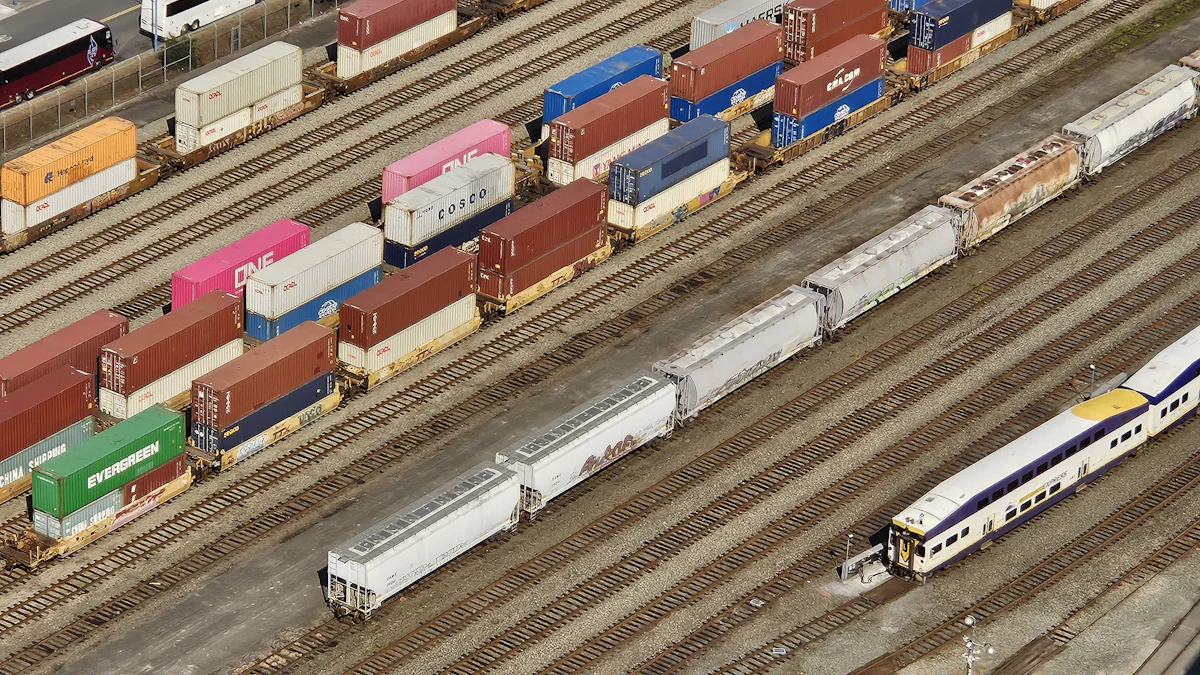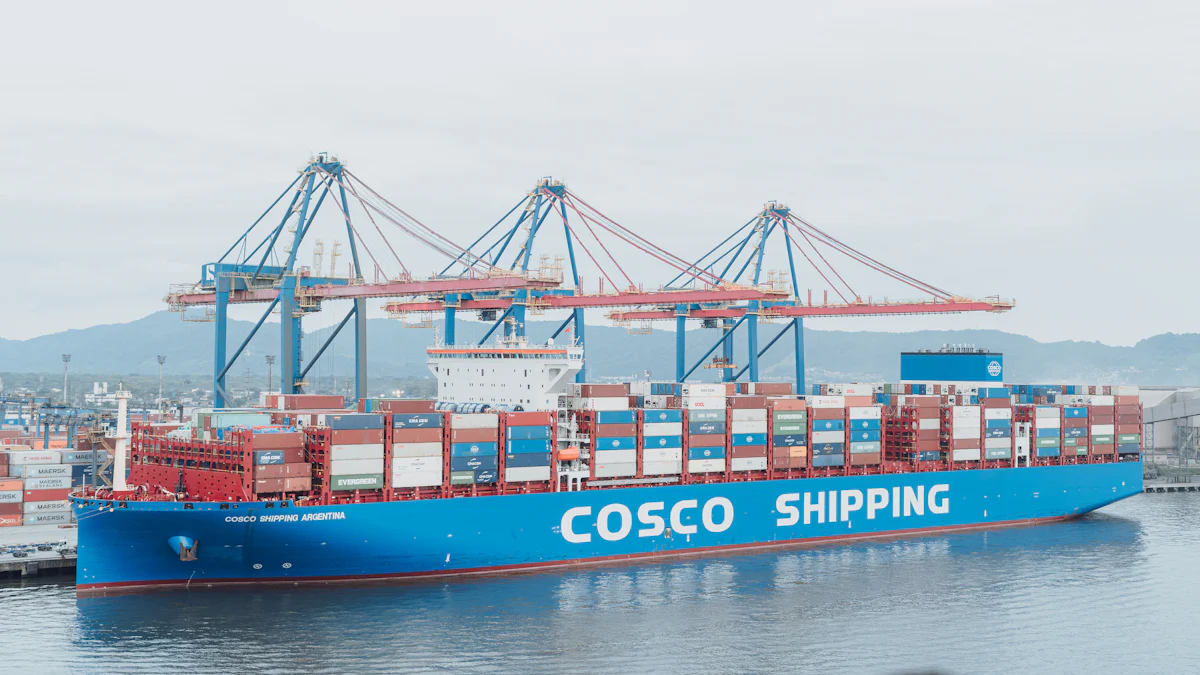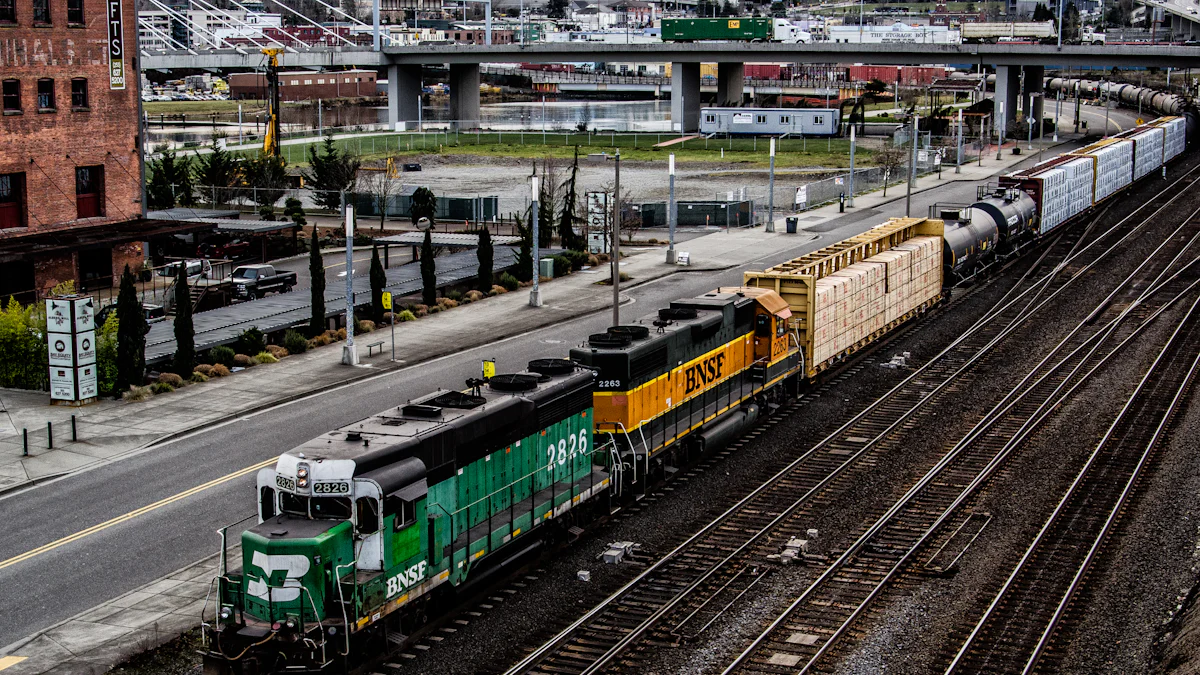Analyzing Market Growth of China-Europe Rail Transport in 2025

The china-europe rail transport sector is poised for remarkable expansion, with its market size projected to grow exponentially. By 2025, the china-europe railway is expected to play a pivotal role in global trade, connecting over 30 countries across Eurasia. This network offers a faster and more cost-effective alternative to sea and air freight, reshaping logistics dynamics. The china-europe railways have already demonstrated significant growth, with annual trips projected to exceed 17,000 by 2024. JUSDA’s innovative China-Europe Express Rail service has emerged as a key contributor, enhancing efficiency and reliability in this rapidly evolving market.
Current Market Size and Projected Growth of China-Europe Rail Transport

Market Overview and Key Statistics
The china-europe rail freight transport sector has experienced significant expansion in recent years. In 2023, the market size reached an estimated USD 10.08 billion. By 2024, this figure is projected to grow to USD 12.70 billion, reflecting the increasing reliance on rail as a preferred mode of transport. The upward trajectory continues, with forecasts predicting the market will reach USD 40.30 billion by 2029, driven by a compound annual growth rate (CAGR) of 25.99% during the forecast period.
The china-europe railway has become a vital link in global trade, connecting over 30 countries across Eurasia. This network offers a faster and more cost-effective alternative to traditional sea and air transport. Between 2023 and 2025, the growth in freight volumes is expected to accelerate, supported by rising demand for efficient logistics solutions. The number of annual trips is projected to exceed 17,000 by 2024, highlighting the increasing importance of this corridor in facilitating trade between china and europe.
"The proportion of eastbound to westbound trains has significantly increased, rising from 50.6% in 2016 to 81.5% in 2021, indicating a growing demand for rail transport from China to Europe."
This shift underscores the evolving dynamics of the china-europe rail freight market, where the balance between eastbound and westbound freight volume continues to improve. The steady growth of this sector reflects its critical role in meeting the logistical needs of businesses across diverse industries.
Role of JUSDA in Supporting Market Growth
JUSDA has emerged as a key player in the china-europe rail freight transport sector. Its China-Europe Express Rail service has significantly contributed to the market's expansion by offering innovative and reliable logistics solutions. This service bridges the gap between speed and cost, providing businesses with an efficient alternative to traditional modes of transport.
Contribution of JUSDA's China-Europe Express Rail to the Market's Expansion
JUSDA's China-Europe Express Rail service has played a pivotal role in enhancing the efficiency of the china-europe railway. By reducing transit times to 15-20 days, it offers a faster option compared to sea freight while remaining more cost-effective than air freight. This balance has made it an attractive choice for businesses seeking to optimize their supply chains. The service has also supported the growth of the china-europe rail freight market by enabling the seamless movement of goods such as electronics, clothing, and medical supplies.
Key Features and Advantages of JUSDA's Rail Service
JUSDA's rail service stands out due to its unique features and advantages:
Speed and Cost Efficiency: The service provides a transit time of 15-20 days, significantly faster than sea freight and more affordable than air freight.
Diverse Cargo Handling: It accommodates a wide range of goods, including electronic products, small commodities, and temperature-sensitive medical supplies.
Seamless Customs Operations: JUSDA leverages its extensive network to ensure smooth customs clearance, minimizing delays and disruptions.
Intermodal Connectivity: The service integrates rail with other modes of transport, such as sea and road, to enhance logistical flexibility.
These features position JUSDA as a leader in the china-europe rail freight transport sector, driving the growth of the market while meeting the evolving needs of global businesses.
Key Drivers of Growth in China-Europe Rail Freight Transport
Political and Economic Factors
Impact of the Belt and Road Initiative (BRI) on Rail Infrastructure Development
The Belt and Road Initiative (BRI) has significantly influenced the expansion of the china-europe rail freight transport network. This ambitious strategy, launched by the government of china, aims to restore the ancient Silk Road by fostering connectivity across Eurasia. Substantial investments in rail infrastructure have enhanced the efficiency and capacity of the transport corridor, enabling seamless trade between china and europe. The development of the China-Europe Railway Express under the BRI has strengthened economic collaboration among participating nations, creating a vital bridge for asia-europe trade.
"The China-Europe Railway Express plays a pivotal role in the Belt and Road Initiative by enhancing connectivity and fostering economic collaboration among countries along the ancient Silk Road and beyond."
This initiative has not only improved rail infrastructure but also encouraged the adoption of advanced logistics technologies, further boosting the market's potential.
Trade Agreements Between China and Europe Boosting Rail Freight Demand
Trade agreements between china and europe have played a crucial role in driving the growth of china-europe rail freight transport. These agreements have simplified customs procedures, reduced tariffs, and promoted open cooperation. As a result, businesses across diverse industries now rely on rail transport to meet their logistical needs. The increasing demand for efficient and reliable trade solutions has positioned the china-europe railway as a preferred mode of transport, contributing to the market's expansion.
Technological Advancements in Rail Freight
Role of Digital Platforms Like JUSDA's JusLink in Enhancing Logistics Efficiency
Technological advancements have revolutionized the china-europe rail freight transport sector. Digital platforms like JUSDA's JusLink have emerged as game-changers, offering real-time tracking and supply chain optimization. JusLink integrates IoT, cloud computing, and big data to enhance transparency and efficiency in logistics operations. This innovation has enabled businesses to streamline their supply chains, reduce costs, and improve service delivery, further solidifying the market's growth trajectory.
Innovations in Rail Freight Technology Improving Speed and Reliability
Innovations in rail freight technology have significantly improved the speed and reliability of china-europe rail freight transport. Advanced rail systems, automated cargo handling, and predictive maintenance tools have minimized delays and enhanced operational efficiency. These technological breakthroughs have made rail transport a competitive alternative to traditional modes, such as sea and air freight, driving the market's growth and meeting the evolving demands of asia-europe trade.
Sustainability and Market Dynamics
Rail Transport as a Sustainable Alternative to Air and Sea Freight
Rail transport has gained recognition as a sustainable alternative to air and sea freight. The lower carbon emissions associated with rail make it an environmentally friendly option for businesses seeking to reduce their ecological footprint. The china-europe rail freight transport network has become a key player in promoting sustainable logistics solutions, aligning with global efforts to combat climate change.
Growing Demand for Cost-Effective and Environmentally Friendly Logistics Solutions
The growing demand for cost-effective and environmentally friendly logistics solutions has fueled the expansion of the china-europe rail freight transport market. Businesses increasingly prioritize sustainability and affordability in their supply chain strategies. Rail transport offers a unique balance of speed, cost efficiency, and environmental benefits, making it an attractive choice for companies engaged in china-europe trade. This shift in market dynamics underscores the critical role of rail transport in shaping the future of global trade.
Challenges and Limitations in China-Europe Rail Transport
Geopolitical and Regulatory Challenges
Impact of Geopolitical Tensions on Trade Routes and Rail Operations
Geopolitical tensions present significant challenges to the smooth operation of the china-europe rail freight transport network. Political instability in regions along the railway routes can disrupt the flow of goods, causing delays and increasing operational risks. For instance, fluctuating diplomatic relations between china and certain European nations have occasionally led to interruptions in trade agreements, impacting the reliability of transport services. Additionally, conflicts or unrest in transit countries may force rerouting, which increases transit times and costs.
The china-europe rail freight transport system benefits from robust infrastructure and strategic planning, but it remains vulnerable to external political factors. Governments and stakeholders must collaborate to mitigate these risks by fostering stable diplomatic relations and ensuring contingency plans are in place to address potential disruptions.
Regulatory Differences Between China and European Countries
Regulatory discrepancies between china and europe create another layer of complexity for the china-europe rail freight transport sector. Each country along the railway routes enforces its own set of customs regulations, safety standards, and operational protocols. These differences often result in delays at border crossings, as goods must undergo multiple inspections and comply with varying requirements.
For example, the European Union's stringent environmental and safety standards may conflict with china's regulatory framework, leading to inefficiencies in freight services. Harmonizing these regulations through bilateral agreements or international frameworks could streamline operations and enhance the overall efficiency of the market.
Infrastructure and Capacity Constraints
Bottlenecks in Rail Infrastructure and Terminal Capacity
The rapid growth of the china-europe rail freight transport sector has exposed bottlenecks in railway infrastructure and terminal capacity. Many terminals along the china-europe railway struggle to handle the increasing volume of goods, leading to congestion and delays. Insufficient loading and unloading facilities further exacerbate these issues, reducing the efficiency of transport operations.
For instance, the Duisburg Port in Germany, a critical hub for china-europe rail freight transport, has faced challenges in accommodating the surge in cargo volumes. Investments in expanding terminal capacity and upgrading railway infrastructure are essential to address these bottlenecks and support the continued growth of the market.
Limited Availability of Railcars and Containers Affecting Freight Volumes
The limited availability of railcars and containers poses another significant challenge for the china-europe rail freight transport sector. The imbalance in traffic flow, with more goods being transported westbound from china to europe, has created shortages of empty containers for eastbound shipments. This imbalance disrupts the supply chain and limits the sector's ability to meet growing demand.
Efforts to optimize container utilization and improve resource allocation are crucial to overcoming this limitation. Stakeholders must also explore innovative solutions, such as intermodal transport, to enhance the flexibility and resilience of the market.
Future Trends and Opportunities in China-Europe Rail Freight Transport

Growth of Intermodal Shipping Solutions
Integration of rail with other transport modes for seamless logistics
The integration of rail with other modes of transport is transforming the china-europe rail freight transport landscape. Businesses increasingly seek seamless logistics solutions to optimize supply chains. Rail transport, when combined with road, sea, or air freight, creates intermodal shipping solutions that enhance efficiency. This approach allows goods to move smoothly across different regions, reducing transit times and costs.
For instance, intermodal solutions enable businesses to transport goods from china to europe by rail and then distribute them locally using trucks. This flexibility ensures that companies can meet delivery deadlines while maintaining cost-effectiveness. The growing adoption of such integrated logistics solutions reflects a significant trend in the market, driven by the need for streamlined operations.
Expansion of multimodal hubs along the China-Europe corridor
Multimodal hubs are emerging as critical infrastructure along the china-europe rail freight transport corridor. These hubs serve as strategic points where goods transition between different modes of transport. Their development supports the increasing demand for efficient logistics solutions.
Key locations, such as Duisburg in Germany and Chengdu in china, have become pivotal in facilitating intermodal connectivity. These hubs enhance the capacity of the transport network, enabling businesses to handle larger volumes of freight. The expansion of such facilities aligns with the market's growth trajectory and underscores the importance of infrastructure in supporting future trends.
Development of Cold-Chain Logistics
Rising demand for temperature-controlled transport for perishable goods
The demand for temperature-controlled transport is rising as businesses prioritize the safe delivery of perishable goods. Cold-chain logistics has become a vital component of the china-europe rail freight transport market. This trend gained momentum during the COVID-19 pandemic when rail transport emerged as a reliable solution for shipping sensitive items.
Cold-chain railway shipping offers a controlled environment for goods such as pharmaceuticals, fresh produce, and frozen foods. The ability to maintain consistent temperatures throughout transit ensures product quality and safety. This development highlights the evolving needs of businesses and the growing role of rail transport in meeting these requirements.
"The coronavirus pandemic has boosted the emergence of new options for the supply chain between Asia and Europe. Cold-chain railway shipping could be one area where new growth is created in eastbound railway shipping."
JUSDA's role in advancing cold-chain logistics through its China-Europe Express Rail
JUSDA has positioned itself as a leader in cold-chain logistics within the china-europe rail freight transport sector. Its China-Europe Express Rail service incorporates advanced temperature control systems to support the transportation of perishable goods. This innovation addresses the market's demand for reliable and efficient cold-chain solutions.
By leveraging its expertise, JUSDA ensures that goods remain in optimal condition throughout the journey. The company's commitment to enhancing cold-chain logistics demonstrates its ability to adapt to market trends and deliver value to businesses.

After the update
Supply Chain Management Solution
Automation and Digitalization in Rail Freight
Adoption of AI and IoT for real-time tracking and supply chain optimization
Automation and digitalization are reshaping the china-europe rail freight transport market. The adoption of technologies such as artificial intelligence (AI) and the Internet of Things (IoT) has revolutionized logistics operations. These tools enable real-time tracking of shipments, providing businesses with greater visibility and control over their supply chains.
AI-powered systems analyze data to optimize routes, predict delays, and improve decision-making. IoT devices monitor the condition of goods during transit, ensuring quality and compliance. These advancements enhance the reliability and efficiency of rail transport, making it a preferred choice for businesses engaged in china-europe trade.
JUSDA's JusLink platform as a leader in digital supply chain solutions
JUSDA's JusLink platform exemplifies the potential of digitalization in the china-europe rail freight transport market. This intelligent supply chain solution integrates IoT, cloud computing, and big data to streamline logistics operations. JusLink provides real-time insights, enabling businesses to track shipments, manage inventory, and optimize supply chains.
The platform's innovative features position JUSDA as a leader in digital supply chain solutions. By embracing automation and digitalization, JUSDA continues to drive the market forward, meeting the evolving needs of global businesses.
The China-Europe rail transport sector is set to redefine global trade by 2025, with its exponential market growth and strategic significance. Key drivers such as technological advancements, sustainability, and intermodal solutions have propelled this market forward, while challenges like infrastructure constraints and regulatory differences demand innovative solutions. Future opportunities, including cold-chain logistics and digitalization, promise to further enhance the market's potential. JUSDA's pioneering efforts, from its China-Europe Express Rail service to its JusLink platform, position it as a transformative force in bridging economic and geographical gaps between China and Europe.
See Also
Exploring LTL Freight's Future Through In-Depth Insights
Five Key Trends Shaping Future Supply Chain Efficiency
Get Prepared: Discovering New Transport Tech for Supply Chains
2024 Insights: Uncovering Innovations in Sea Freight Logistics
Addressing Global Supply Chain Growth Challenges Effectively
